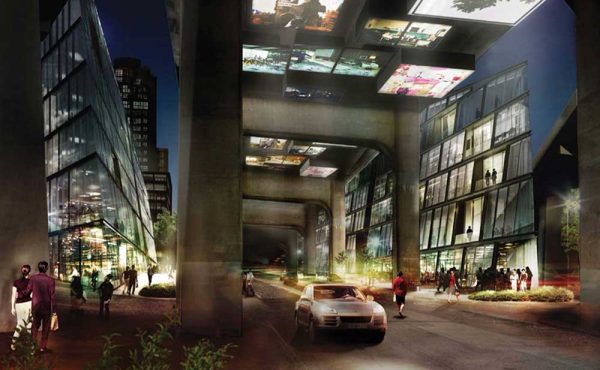
Planning Pool shares the highlights of the Canadian Institute of Planners Conference. Although the conference was in Ontario, BC was the topic of much conversation.
By Daniella Fergusson and Vanessa Kay, Planning Pool
It is 8:00am on the last day of the 2009 Canadian Institute of Planners (CIP) Conference, and the lights in the hotel room won’t turn on. The power is out. Vanessa and Daniella, two urban planning students at the University of British Columbia, wonder aloud whether the day’s sessions will be cancelled. Venturing down to the conference hall, our intrepid bloggers find a windowless room large enough to fit 1,000 people filled with candles. Chris Turner, the author of Geography of Hope, projects his unassisted voice to the back of the hall and paints pictures of places he has been with stories, since we cannot simply watch his slide show. He speaks of European towns and villages that naturally achieve trendy planning goals, like walkability, high density with liveability, and mixed uses. In other words, he says we should look back at the form towns and cities of 100 years ago to go forward. After three days of talks and workshops focusing on how orthodox planning has to change, as a result of climate change, peak oil, congestion, and changing demographics, ending the conference in the dark seemed very appropriate.
Ironically (in hindsight), we traveled from Vancouver to Niagara Falls to represent Planning Pool at a session called the Interactive Media Café, a showcase of “alternative” communication and engagement tools for planning, such as blogs and podcasts. We believe that social media is becoming tremendously important as a platform for planning discourse, and we were demonstrating various tools as examples. When we weren’t presenting, we attended the plenary and concurrent sessions and liveblogged some of our favourites on laptops and cell phones. At the end of the conference, we realized that the most engaging parts of it had been the personal and informal activities, especially the small breakout sessions when researchers and practitioners shared their insights and engaged in dialogue with the audience. If there isn’t a rule already, we’re going to postulate that the interestingness of a presentation is inversely proportionate to the number of words and slides it involves!
Now that we have returned home and have had time to reflect, we’d like to share a sampling of our favourite conference moments. Each post is also linked back to where the relevant session was liveblogged on Planning Pool, so read on if you’re curious what you may have missed at the CIP conference!
A number of speakers presented changes in direction for planning norms. For example, for the past few decades, we’ve been building sprawling cities that now are becoming congested and expensive to maintain. Planners have had to rethink how we deal with edge cities and transnational mega-regions, because they just don’t work. In a session called, From Edge City to Urban Place: Tysons Corner revisited, the speakers compared Tysons Corner and Mississauga, ON. The former, a rapidly growing and desirable suburb of Washington D.C., aims to become denser and more walkable by focusing on transit-oriented development. The latter, experiencing stagnation on the outskirts of Toronto, is hoping to create a beautiful Main Street in order to attract new development that can raise property values enough that density becomes feasible. Another norm that is beginning to change is governance structures at the regional level, especially as regions cross state/provincial and international boundaries. In Building a Regional City, the speakers illuminated the governance barriers to North America’s transnational mega-regions: Cali-Baja, Cascadia, and Tor-Buff-Chester. Regional governance is needed to manage these areas, not just because of the land they cover, but also to manage services like transit, water, waste, and development codes and incentives.
Planners realize that we’re facing an aging population, and this seemed to be a major concern at the conference. A session entitled, Old Age Ain’t for Sissies and What that Means for Planners, generated plenty of lively discussion. A wonderful interdisciplinary approach uncovered multiple dimensions of the issue: a planner talked about the changing physical needs of seniors as they age, and a graduate student drew our attention to the Vancouver Island example of Saanich, where the WHO Guide to Global Age Friendly Cities is informing new physical design guidelines and social initiatives. Finally, a community organizer spoke about the critical need for tolerance and cross-cultural dialogue between youth and the elderly. Audience members had plenty of stories, concerns and advice to share – one common theme of their comments was the need for social change in addition to coordinated planning approaches.
Probably our favourite session was the one with the liveliest dialogue, a session entitled What Planners can Bring to the Table in a Recession: Planners’ Improv. The expert panel surprised attendees by following their brief introduction by posing the open question of how planners can best do their work in the current context of economic collapse. After all, the people in the room, a cross-section of Canadian planners, were experts too! After a tentative start, 90 minutes of rich and spirited discussion ensued, as planners from every sector and every kind of Canadian community shared their experience, predictions, and sought advice from each other about the economic predicament in their community.
Overall, the conference covered a variety of issues, ranging from the recession to climate change. The conference’s ending in the dark seemed fitting, as many solutions presented to current urban problems were throwbacks to how things used to be done. Also, our future remains unknown: the possibility of drastic climate change and peak oil could mean conferences of the future are held by candlelight more often. On the positive side, we were excited to see British Columbia as a topic of conversation and celebration. Vancouver’s Ann McAfee compared Vancouver to Melbourne as examples of liveable cities. Gordon Harris spoke about ageing in BC. The City of Vancouver won a CIP Award for Planning Excellence for its EcoDensity Initiative. In addition, the Town of Ladysmith and HB Lanarc also won an award for the town’s Sustainable Community Visioning Project. We hope that you have some thoughts and reactions to some of the ideas presented at the CIP conference, and we warmly welcome you to discuss them in the comments below, or on Planning Pool.
***
Daniella Fergusson has a background in political science and economics. She employs a multidisciplinary approach to solve environmental, economic, and social sustainability challenges. She blends her vast international travel to over 25 countries in the past four years with government, private, and non-profit experience to create sustainable solutions. Read her SCARP profile here.
Vanessa Kay is a Masters’ student at the University of British Columbia’s School of Community and Regional Planning. Her special interests include walkable cities and urban food security.



